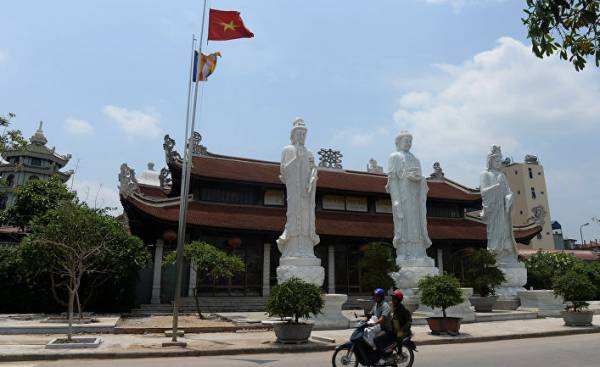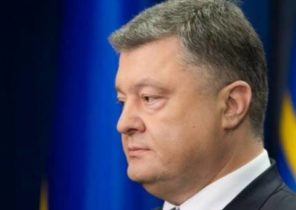
In 1968 it was the Western dream: the beach and the cobblestones. And then to hold demonstrations in Paris, Frankfurt and West Berlin, studied well the students brought with them large posters with Lenin and Mao and chanted in unison: “Ho Ho Ho Chi Minh!”
And today? Now in the big South Vietnamese port of Ho Chi Minh city, also known under its old name Saigon, fashionably dressed teenagers with their smartphones face the white-bearded Communist monument to this national hero and take a selfie of “me and uncle Ho” in that individualistic order. Background pictures for aesthetic reasons includes the town hall, built in 1908 by the French colonialists, today it is the residence of the “people’s Committee”. On the roof of a red flag with a star.
But despite this symbolism, despite all those monuments and red flags, the question arises: how communism is still strong in Vietnam? And in the neighboring country Laos, which since 1975 is officially called “democratic people’s Republic”?
Vietnam ruled by the Communist Party of unity
At first glance, Saigon calm prevails, especially at the end of the week when the bridge Boulevard Nguyen becomes a centre of entertainment and leisure. Left guitar (strumming the guitar is not party songs, but rather trying to sing Simon&Garfunkel), right phalanx mobile street kitchens with restaurants in the background, offering foreign tourists and the wonderful local night owls emerging middle class Vietnamese cuisine is a noble and ambitious manner, including cocktails of the “Sex on the beach” or “Singapore sling”.
40-storey hotel Nobel “The Reverdie”, the new high-rise buildings with glass facades, who grew up in Saigon over the years at breakneck speed, illuminated at night in the colours of the French flag blue, white and red.
“Uncle Ho” and the former Saigon
So, on the streets of Saigon a good quiet life, which, apparently, no longer has anything in common with the old Communist doctrine of collective ascetic sacrifice. And under them? “You see surveillance cameras on the tops of the trees? Once it’s on the strip and formed some kind of mini-demonstration from the ground appears the riot police with their batons, because the earth is the center of control, stuffed with screens.”
So, under the bridge continued repression? Indeed, cost-increasing but still controlled by the Communist Party of the unity of Vietnam is no accident sadly is top of the list of those countries that impose the draconian sentences bloggers to spread critical articles on the Internet.
In the strictly controlled state media, it is impossible to know all this, but surprisingly fearless those students or young small businesses that are in the clubs and bars of the type “Republic” or “Apokalypse Now”, speaking with a foreign guest in perfect English, give him a quasi-real wine. “Until then, until we can speak openly, — said one of them, will not leave us alone. Even among College friends you need to be careful with the political comments.”
Propaganda of Uncle Ho near Tim&Struppi in Saigon
If it were not aware of the existence of repressive underground, then it would be impossible to know anything for in the West the elegant streets of Saigon. So luxurious walking street entertainment, in 1975 renamed Dong Khoi (“popular Uprising Street”), has long been reminiscent of the old noble Katina Rue (Rue Catinat) French colonial times.
Old Opera, at the time, built on the model of the Parisian Théâtre du Châtelet, standing in the white glow, and the building across the street with his branch of the Dior-Chanel-Versace-Armani. The newsagent that sells everything you want heart of the Western reader. It’s not censored party press, for example, “Viêt Nam News” in English and “Le Monde”, “The Australian”, “Wall Street Journal”.
Anyway, it’s amazing how in small pavilions next to the imposing post office building, built in 1891 by Gustave Eiffel, light up pictures of various contents. It is retouched in the manner of Andy Warhol’s paintings in the frames, showing Putin, Obama, Che Guevara, Rihanna, Michael Jackson, and North Korean dictator Kim.
Here you can find a vivid propaganda posters Uncle Ho and dark brown pictures colonial time. There are magnets on the fridge with a picture of Tim&Struppi, who go on a rickshaw on the streets of Saigon. The official name of Ho Chi Minh city can be hard to find in the townscape, and if you found it, just as a beautiful acronym: HCM City.
Even the elderly habitually take out their smartphones
At the reunification Palace, the former residence of the South Vietnamese government, which on 30 April 1975 was taken by the victorious forces of the Communist North, there is a new cause for surprise. What a striking transformation!
Those foreigners who ten years ago had examined this building, built in the sixties in the style of art Nouveau then, could meet the surprised locals: military and police Junior ranks who visited the city, hunched old women and men with angular faces, reverently examined a bourgeois luxury.
Today, by contrast, even the elderly absolutely habitually take out their smartphones to photograph this aesthetics of Persian carpets, crystal chandeliers and glass tables, the former Pro-Western owner of this building. While the young one and all in perfect English give your comments the same way as their Western peers. Here is “retro”, this Museum is a Palace!
In the basement, with space hoppers, with the then means of communication and listening, now heard loud laughter. caused by the bulky form of the technique of the dinosaur era. I wonder if these young people about the existing Boulevard underground control center of the Communists, in power since 1975?
Homes of the new rich with Golf courses and swimming pools
Coming to Vietnam soon learn: there are questions that are better not to ask. This applies to the hustle and bustle of the Old town in Hanoi, which arrives after a short flight from Saigon. This also applies to the narrow space of the shop, the owner of which on a green tree, attached sidewalk advertising sign “We sell old propaganda posters and SIM card”.
Support or Subversion? In terms of 20 Euro for one of the posters that reveal Uncle Ho with the bust of Lenin, or shot down American planes in the background. Even in the late phase of the GDR, thinks arrived, this was impossible.
Not to mention the difference in attractiveness between East German cities in 1989 and modern Hanoi. Its colorful houses of the Old town, high and narrow, with many small rooms and patios, are constantly restaurerede. In the capital, has long been economically (and absolutely not politically), which entered into the market economy of socialist dullness, on the periphery, meanwhile, exist on the American model, even “gated communities”, private residential blocks for the new rich with Golf courses and swimming pools.
The old town looks even more alive and attractive, being surrounded by Literary Buddhist temple, Confucian Academy 11th century, the Catholic neo-Gothic St. Joseph’s Cathedral 1886 and streets, walking around the city lake, Hoan Kiem lake with its famous Temple island.
Whether the new Hanoi to Bangkok?
Still there are rickshaw is a traditional vehicle survived colonialism. But it is gradually replacing. For about 20 years it gives way to the successful mopeds and small cars of Japanese production.
But in the narrow streets, named for the Guild of local craftsmen, such as bakers, blacksmiths or potters, Bicycle rickshaws are still functioning — to the delight of tourists who are slowly passing under the trees, past the shops. These latter filled with fruit, shoes, fabrics and Handicrafts artisans.
Communist economy of scarcity? Flash in the pan. Instead of street food near bistro à la française, Boutique hotels near cheap hotels cheap Traveller and a tour Desk for trips around the country. Hanoi, new Bangkok, with depressing prostitution and selling drugs? If it never happened. Here fashionable after midnight walk to bars walk literally fabulously lighted promenade and quite aimlessly to engage in conversation with a local resident.
The lucky ones might even recognize a certain mystery, which makes impressions of Saigon and Hanoi more mundane: “While we’re not talking about politics, we can do what we, the Vietnamese, has always been in the blood: to learn and to do business. And use the chance our parents and grandparents did not dare even to think.”
And here’s the proof directly in the official Museum of Ho Chi Minh city. Though this concrete block with its sterile luxury is still a Stalinist surrealism, but at the exit it is quite different.
There the resourceful entrepreneur has altered cut from the tire sandals of the Viet Cong soldiers who fought in the jungle, the chic brand: cardboard note, equipped with a red star attached to the strap sandals all sizes cut out of tyres, in terms of costs 15 euros. The newcomer is the first and last time it saw a long queue.
In Laos is much slower
Got this triumphant train of capitalist trade and to Laos? Not really. “The Vietnamese are faster than us,” can be heard in Vientiane, the capital of the neighboring country. “Now in Vietnam, gays can even get married…” And here, officially still the “people’s democratic Republic”, where in 1975 after the Communist victory was also omitted the so-called “bamboo curtain” and to this day dominates the one-party regime?
This is the students prefer not to speak, even here, at the tables in the bushy garden bar “CCC Bar””, the only gay bar in Vientiane. But here as free people comes and goes! Travelers with backpacks walk past. And behind the bar stands the owner of the hotel, Indian by birth, who with his wife, daughter, cousin and brother contains one of the many new cheap hotels of the middle class.
Magic of the Mekong on each a section of the river
The one who as the traveller arrives in Vientiane, quickly get the feeling that he knows almost every resident of the city, with a population of 210 thousand people, including few tourists. The latter are here primarily to explore the numerous glittering gold red temples and a triumphal arch with decorations in Asian style or to spend time in a beautiful new restaurants built in French colonial style. Quiet, friendly, calm, it seems that here the Mekong flows more smoothly.
Cassette tape recorder and the seeds from the GDR
In the evening on the embankment of the usual fuss and phone calls, but during the day it is such a nice peace of mind that even the driver motorickshaws gives a sharp whistle, and silently brings his mini-TRANSPORTNOE means to ask, where would you like to go to the canopy stretched out the city. “In the national Museum or the Museum of the founder of the state?”
The surprise of the driver suggests that the Laotians do not attach much importance to the national pomp and propaganda. Not that the latter was not in the National Museum, here is a picture long faded party grandees within the dusty glass, letters, glued on the obliquely cut strips of paper, in French, telling about the socialist future. There has long been flashed green geckos, and trembling outside bursts into the sunlight through the old door panels. What an enchanted place!
And as the addition a Museum of a private house Kaysone Phomvihane (Kaysone Phomvihane), who died in 1992 — the “Father of Lao communism.” Here, too, is hard to find other visitors, locals or foreigners here, too many staff with great friendliness shows the exhibits of the house, built in the Bauhaus style: a cassette player from East Germany, 22 volumes of Lenin’s works, documents of the Cuban Communist party, a couch and above it a portrait of Uncle Ho Vietnamese, and even a tiny crumpled bags of seeds Brussels sprouts one “state enterprise of the GDR.”
“Society has gone far beyond the policy”
So, here surrealism. But when I asked the friendly Dr. Cooper (Cooper, 70 years), the only private bookseller Vientiane, the British anthropologist and writer, to say something about the absurd interior of the home of the former ruler, he only smiled slightly.
Quiet magic — a trip on the Mekong
He does not comment — not a single word. Instead, he talks about his pregnant wife, Lao, and walk around in your cute “Book-Café” on the parallel street behind the promenade of the Mekong and offers to buy your novel in a plastic wrapper, “Our man in Laos”, a comic retelling of “Our man in Havana”, a former best-seller, written by a countryman of Dr. Cooper Graham Greene (Graham Greene). But this Thriller is not something that avoids criticism, even mentioning the still ruling in Laos of communism.
Is friendly the tropical calm of Vientiane in the same deceptive walk on a Saigon Boulevard under the bridge which is a division with clubs? Yes and no. Because, despite everything, remains the fact that not only Vietnamese, but also Laotians now have much more freedom than their predecessors. “Society has gone far beyond the policy, said one of the students in the bar “CCC-Bar is supposed to get up there.”






